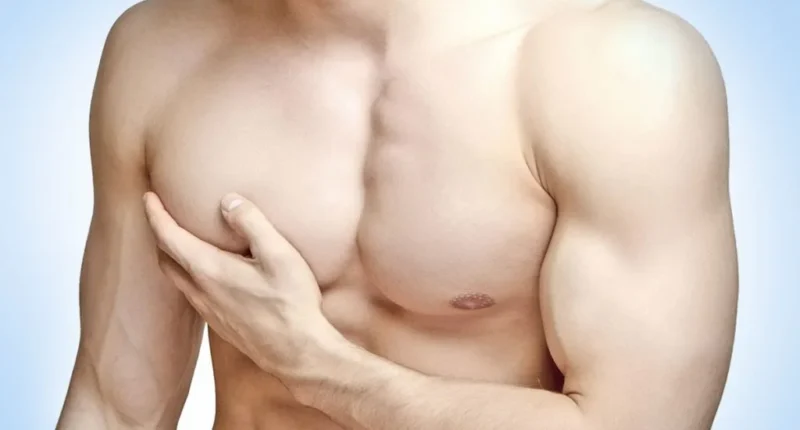
Breast enlargement can affect men of all ages, including newborns, during puberty, and older men. Gynecomastia is the result of excess breast tissue rather than fat. Exercising or losing weight will not reduce breast tissue in gynecomastia.
Pseudogynecomastia is a different condition where fat accumulates in the breasts, possibly due to a person being overweight or obese.
Gynecomastia and its Signs and Symptoms
Gynecomastia is usually not a serious problem.
Symptoms include swelling and tenderness in the mammary gland tissue of one or both breasts. It can start as a lump or fatty tissue around a person’s nipple. In most cases, the lumps will develop unevenly.
It is important for people to consult a doctor if there is unusual and persistent swelling, pain, nipple discharge, or a combination of the two.
Diagnosing Gynecomastia
A doctor will ask about a person’s symptoms, medical and drug history, and possibly family history. A physical examination will be performed of breast tissue, which may also extend to the genitals and abdomen.
If the cause appears to be a hormone imbalance, the doctor may recommend that the condition resolve on its own without treatment.
If the lump is unusually large, tender, or unilateral, the doctor may order a biopsy or blood test to rule out breast cancer.
Further tests will try to rule out other causes, such as:
- cyst
- abscess or furuncle
- benign tumor such as lipoma or hamartoma
- mastitis, which is inflammation of breast tissue
- hematoma, a solid swelling of clotted blood
- metastasis, a cancer that has spread from elsewhere in the body
- fat necrosis or a lump resulting from damage to fatty breast tissue
The doctor may also order imaging tests that include:
- mammograms or breast ultrasounds
- chest X-rays
- MRI scans
- testicles ultrasounds
Causes of Gynecomastia
Several factors can cause gynecomastia.
Gynecomastia can be caused by an imbalance between the sex hormones testosterone and estrogen. Estrogen allows breast tissue to grow, while testosterone prevents estrogen from growing breast tissue.
Although both men and women have testosterone and estrogen, testosterone is usually higher in men and estrogen is higher in women. Infants and young boys can develop gynecomastia because their hormones fluctuate during development. However, it usually resolves on its own.
Swollen breasts can reoccur in men approaching older age. Older men produce less testosterone and have more body fat than younger men, which can increase estrogen levels.
Some men will develop this condition with herbal products or medications, such as:
- anabolic steroids
- antibiotics
- ulcer medications
- chemotherapy
- tricyclic antidepressants
- diazepam and other drugs for treating anxiety
- Some HIV medications, including efavirenz
- anti-androgens
- some heart disease drugs, including calcium channel blockers
Treatment Options for Gynecomastia
Gynecomastia usually resolves without treatment within 6 months to 2-3 years. However, if there is an underlying condition, it may require treatment.
If the condition is caused by a medication, the person may need to switch to another medication. If the person is using the drug for a short period of time, the condition will be temporary.
Treatment is rare but may include breast reduction surgery or hormone therapy to block estrogen.
Medications for the Treatment of Gynecomastia
Tamoxifen is a drug that blocks the action of the female hormone estrogen in the body. It is usually a treatment for breast cancer, but it can also reduce the symptoms of breast pain and breast enlargement in men.
Aromatase inhibitors are a common treatment for breast and ovarian cancer in postmenopausal people, but they can also prevent or treat gynecomastia.
Testosterone replacement can treat gynecomastia in older men with low testosterone levels.Gynecomastia vs. fat
Surgery for Gynecomastia
Breasts are composed of firm and dense glandular tissue and soft fatty tissue.
The ratio of glandular to fatty tissue in the breasts varies between individuals. A man with gynecomastia may have an excess of both types of tissue.
Liposuction can remove excess fatty tissue. This involves inserting a small tube through an incision. Excision involves cutting tissue with a scalpel to remove excess glandular tissue. This will usually leave a scar around the edge of the nipple.
If a large reduction in tissue and skin is necessary, the incision and scar will be larger.
After surgery, the chest will be sore and swollen, and the person may need to wear an elastic compression garment to reduce swelling.
It usually takes about 6 weeks for people to get back to normal. Complications from surgery are rare. These include inadequate removal of breast tissue, uneven breast shape, and loss of sensation in one or both nipples.
Extraction may cause blood clot formation, which may require drainage.
Gynecomastia vs. Fat
Gynecomastia is a condition that causes breast tissue to enlarge. This can be as a result of hormonal changes that promote the growth of breast tissue. Gynecomastia does not cause accumulation of fat in the body and is not related to obesity.
A person who is overweight or obese will have fat around their body. This can result in breast enlargement in men. However, this enlargement is caused by fat rather than tissue growth, as in gynecomastia.









